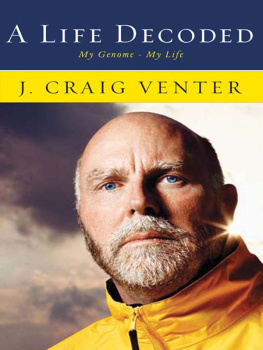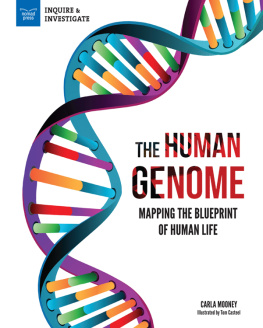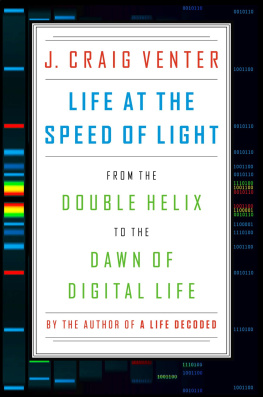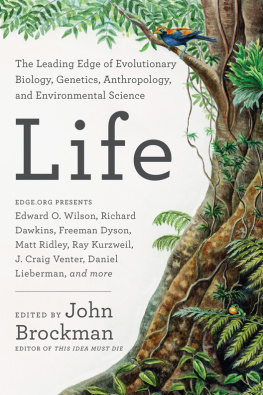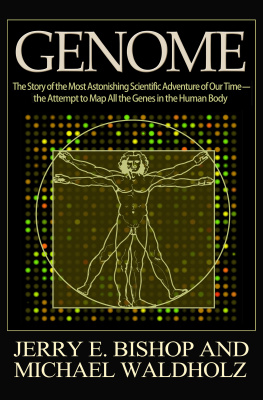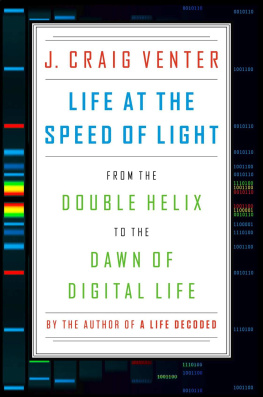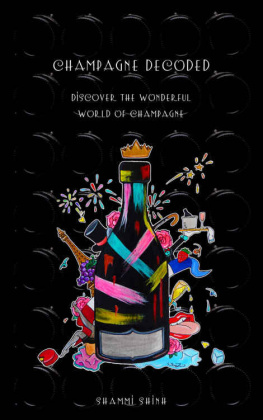* Seven months later Claire followed her new husband to the University of Maryland.
J. CRAIG VENTER
A LIFE DECODED
MY GENOME: MY LIFE
VIKING
VIKING
Published by the Penguin Group
Penguin Group (USA) Inc., 375 Hudson Street, New York, New York 10014, U.S.A.
Penguin Group (Canada), 90 Eglinton Avenue East, Suite 700, Toronto, Ontario, Canada M4P 2Y3
(a division of Pearson Penguin Canada Inc.)
Penguin Books Ltd, 80 Strand, London WC2R 0RL, England
Penguin Ireland, 25 St. Stephens Green, Dublin 2, Ireland (a division of Penguin Books Ltd)
Penguin Books Australia Ltd, 250 Camberwell Road, Camberwell, Victoria 3124, Australia
(a division of Pearson Australia Group Pty Ltd)
Penguin Books India Pvt Ltd, 11 Community Centre, Panchsheel Park, New Delhi110 017, India Penguin Group (NZ), 67 Apollo Drive, Rosedale, North Shore 0632, New Zealand
(a division of Pearson New Zealand Ltd)
Penguin Books (South Africa) (Pty) Ltd, 24 Sturdee Avenue, Rosebank, Johannesburg 2196, South Africa
Penguin Books Ltd, Registered Offices: 80 Strand, London WC2R 0RL, England
First published in 2007 by Viking Penguin, a member of Penguin Group (USA) Inc.
Copyright J. Craig Venter, 2007
All rights reserved
ISBN: 978-1-1012-0256-2
Without limiting the rights under copyright reserved above, no part of this publication may be reproduced, stored in or introduced into a retrieval system, or transmitted, in any form or by any means (electronic, mechanical, photocopying, recording or otherwise), without the prior written permission of both the copyright owner and the above publisher of this book.
The scanning, uploading, and distribution of this book via the Internet or via any other means without the permission of the publisher is illegal and punishable by law. Please purchase only authorized electronic editions and do not participate in or encourage electronic piracy of copyrightable materials. Your support of the authors rights is appreciated.
To my son, Christopher Emrys Rae Venter, and my parents, John and Elizabeth Venter
CONTENTS
A LIFE DECODED
INTRODUCTION
DNA neither cares nor knows. DNA just is. And we dance to its music.
Richard Dawkins
DNA provides the music. Our cells and the environment provide the orchestra.
J. Craig Venter
T raditional autobiography has generally had a poor press. The novelist Daphne du Maurier condemned all examples of this literary form as self-indulgent. Others have quipped that autobiography reveals nothing bad about its writer except his memory. George Orwell thought that an autobiography can be trusted only when it reveals something disgraceful. His reason? A man who gives a good account of himself is probably lying. Sam Goldwyn came to this conclusion: I dont think anybody should write his autobiography until after hes dead.
Because I have been fortunate enough to take part in one of the greatest, most exciting, and, potentially, most beneficial scientific adventures of all time, I believe my story is a story well worth tellingeven more so because it became so controversial, for political, economic, and scientific reasonsbut I am well aware of the research that shows that memory is notoriously malleable. I flinch at the thought of claiming that this side of my story is the only truth, because it depends on chance, on many other people, on my recollections and my partial experience of the events that came to influence my life. Since this is also the first biography to benefit from having six billion base pairs of the authors genetic code as an essential appendix, new interpretations of Craig Venter, based on my DNA, will continue to be made long after life has left my body. I have no choice but to leave the ultimate interpretation to you and to history.
This is a tale of seemingly impossible quests and grand objectives. It features great rivalries and bitter disputes, and clashes of egos involving some of the biggest figures in biology. My adventure has swept me from peaks of incredible exhilaration as I marshaled a relatively small but dedicated army of scientists, computers, and robots to achieve what seemed almost impossible, and then plunged me into black pits of depression as I faced opposition from Nobel laureates and senior government officials, my colleagues, and even my wife. Even today some of these memories remain painful. But I still have a great deal of respect for my critics. My opponents were for the most part honorable as we engaged in a battle of ideologies, morals, and ethics. Everyone felt passionately that he had right on his side.
Apart from the sheer excitement of the science that is at the heart of this book, I hope, too, that my story will serve as an inspiration. My early years were hardly a model of focus, discipline, and direction. No one who met me as a teenager could have imagined my going into research and making important discoveries. No one could have predicted the arc of my career. No one could have seen me rise to head a major research effort. And certainly no one could have foreseen the war of words in which I became embroiled, let alone held out much hope that I could ever beat the establishment.
One of the fundamental discoveries I made about myselfearly enough to make use of itwas that I am driven to seize life and to understand it. The motor that pushes me is propelled by more than scientific curiosity. For many years I have been trying to make sense and meaning out of the lives I saw destroyed or maimed due to the government policies that involved us in the war in Vietnam. I have struggled to understand the deaths of two men who were briefly under my care, an eighteen-year-old who should not have been alive at all as a result of his wounds and a thirty-five-year-old who should have survived but gave up.
Decades later, with the benefit of hindsight, perhaps it was inevitable that such experience would have compelled me to understand life in its most intimate detail. Although the two men were ultimately victims of war, the manner of their dying has remained with me. I had witnessed the power of the human spirit, which can be stronger than any drug. There are still so many questions to answer about the workings of the human body and, most mysterious of all, how it is influenced by our state of mind. By facing such basic questions, I was transformed during my short time in Vietnam from a risk taker who shunned the conventions of the 1960s to one who took a major gamble on a career that was far removed from his upbringing. I willed myself through a junior college to a university and ultimately a Ph.D. I became a scientist, focusing initially on the protein molecules that mediate our responses to adrenaline, and then switching to molecular biology to gain access to the tools that would enable me to read the DNA code that determined the structure of the protein molecules for which I was searching. In this way I was ultimately led to the biological instructionsthe genetic codethat the cells use to guide the way proteins are made. My first glimpse of the code of life gave me an appetite to see more. I wanted to look upon the bigger picture: the entire set of genes within an organism, what we call the genome. After nearly a decade of work I developed new techniques that led me to decode the first entire genome of a living species, and the challenge grew to the ultimate, to sequence the human genome. And what greater challenge than to try to understand ones own life in the context of being the first person in history to be able to gaze upon his own genetic legacy, to focus in detail on those segments, regions, and genes that provide a genetic context for his own life and his own complex, unique blend of nature and nurture?

